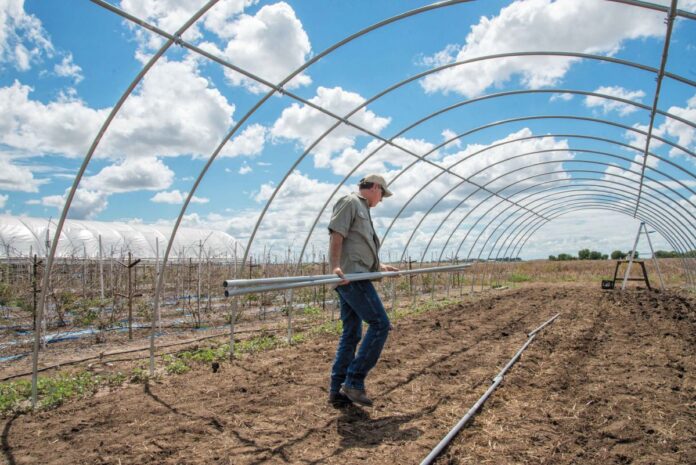LYFORD — More “high tunnel” greenhouses are popping up across the Rio Grande Valley.
Just outside Cruz Salinas’ home, he’s building his second high tunnel to grow strawberries as big as ping-pong balls.
“There are a few being built in the area,” said Osvaldo Longoria, a U.S. Department of Agriculture conservationist who oversees the Valley. “There’s been a great interest by organic farmers and back-door farmers with specialty crops.”
So far, Longoria said, about 10 high tunnels have been built in the Valley.
“Small producers are looking for a niche in their specialty crop,” Longoria said. “It gives them protection if and when we get any frost.”
In August 2014, Salinas used a grant from the USDA’s Natural Resource Conservation Service to build his first high tunnel, a type of unheated greenhouse made of piping under a thick, plastic cover.
Across Lyford’s vast swaths of farmland, the high tunnel rises nearly 13 feet high, standing 20 feet wide and 70 feet long.
“A lot of people come to the house and look at it,” Salinas said. “Some just want to see it.”
During two growing seasons stretching from September to April, Salinas’ high tunnel has yielded bumper crops of fat tycoon tomatoes, each weighing in at about a half-pound.
Starting in December, he harvests about 50 pounds of tomatoes every week.
“They’re real meaty,” said Salinas, the University of Texas Rio Grande Valley’s agriculture specialist.
Now, he’s using a $4,000 NRCS grant to build “the exact same replica,” Salinas said.
He builds his high tunnels to withstand hurricane-force gusts, like the Valley’s fierce spring winds.
With 16-gauge Hurricane fence piping, he builds their frames before using concrete to anchor their posts to the ground.
Then he covers their frames with heavy polyethylene.
This year marks the first time he’ll grow strawberries in a high tunnel.
So far, Salinas has grown his strawberries in rows next to his house.
“I’ve been very successful,” said Salinas, who sells his strawberries at Harlingen’s farmers market.
Salinas gives away his secret.
“It’s the type of soil,” he said.
Salinas grows his strawberries on sandy loam soil.
“It’s real sandy so irrigation water and rain goes through it kind of fast,” he said. “The roots don’t like wet soil. It’s the type of soil watermelons and strawberries like.”
Salinas plans to install a drip irrigation system in the high tunnel.
“If they’re in a high tunnel, I get more protection,” he said. “With a high tunnel, you can control the rain.”
It’s all natural.
For the rest of this story and many other EXTRAS, go to our premium site, www.MyValleyStar.com.
Subscribe to it for only $6.99 per month or purchase a print subscription and receive the online version free, which includes an electronic version of the full newspaper and extra photo galleries, links and other information you can’t find anywhere else.




